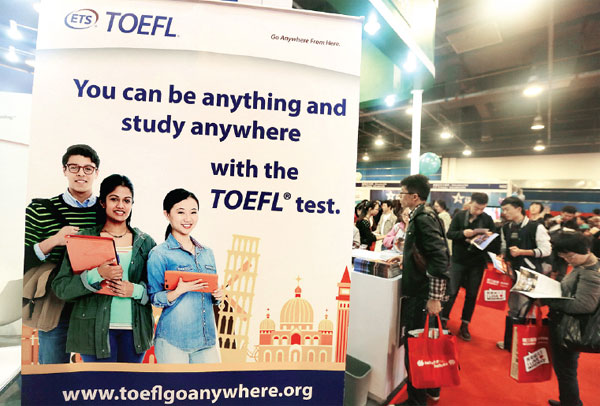TOEFL gives key to study abroad
|
A poster for TOEFL test is displayed at the China Education Expo in Beijing in October. Provided to China Daily |
Exam had lasting impact on students and education
As a member of the Chinese delegation that introduced the Test of English as a Foreign Language to the Chinese mainland, Yang Xuewei still has a fresh memory of the negotiations with the Educational Testing Service as well as the first test in Beijing.
"There were two reasons why we introduced TOEFL. First, as well as the most direct reason, the government wanted to send students to study overseas," Yang said in an interview with Chinese website sohu.com.
"At that time, students needed to fly to the US to take the test. The cost was too high."
Yang said the second reason was that China wanted to learn from the US experience of standardized exams and push educational reform in China.
After months of exchanges, negotiations and discussions between the ETS and Chinese delegations, TOEFL was officially introduced to China in May 1981.
After the delegation came from the US, the exam questions were delivered by ETS to Beijing Foreign Studies University. And then the tests were sent to testing centers in Beijing, Shanghai and Guangzhou, in Guangdong province.
Yang said the first tests were administered in the three cities because ETS thought "these cities had better English teachers and more potential test takers".
Beijing Foreign Studies University turned a large classroom into an exam room, but with more and more students wanting to take the test, the room failed to meet the demand. Another university in Beijing set up a temporary testing center.
The test was quite strict and different from the normal one that Chinese students were familiar with.
To make sure the money that Chinese students spent on TOEFL would not be wasted, a lot of work had to be done.
Before the exam, all test takers gathered in Beijing and were told how the machine-read answer sheet worked. All pencils, erasers and sharpeners were delivered from the US in case the Chinese pencils did not work with the US reading machine.
Liu Chengpei, the late English professor of Beijing Foreign Studies University, said in a 2011 interview with sohu.com that all monitors tried to provide a good environment for students during the test.
"For example, we would not stand more than 30 seconds behind a student, because they would be nervous," said Liu.
The pencils were collected after the exam and kept for the next year's test.
Inspired by TOEFL, the Chinese national college entrance exam developed its standardized reform in 1985.
"The opening-up of China's education field was led by TOEFL," said Yang.
suzhou@chinadaily.com.cn



















